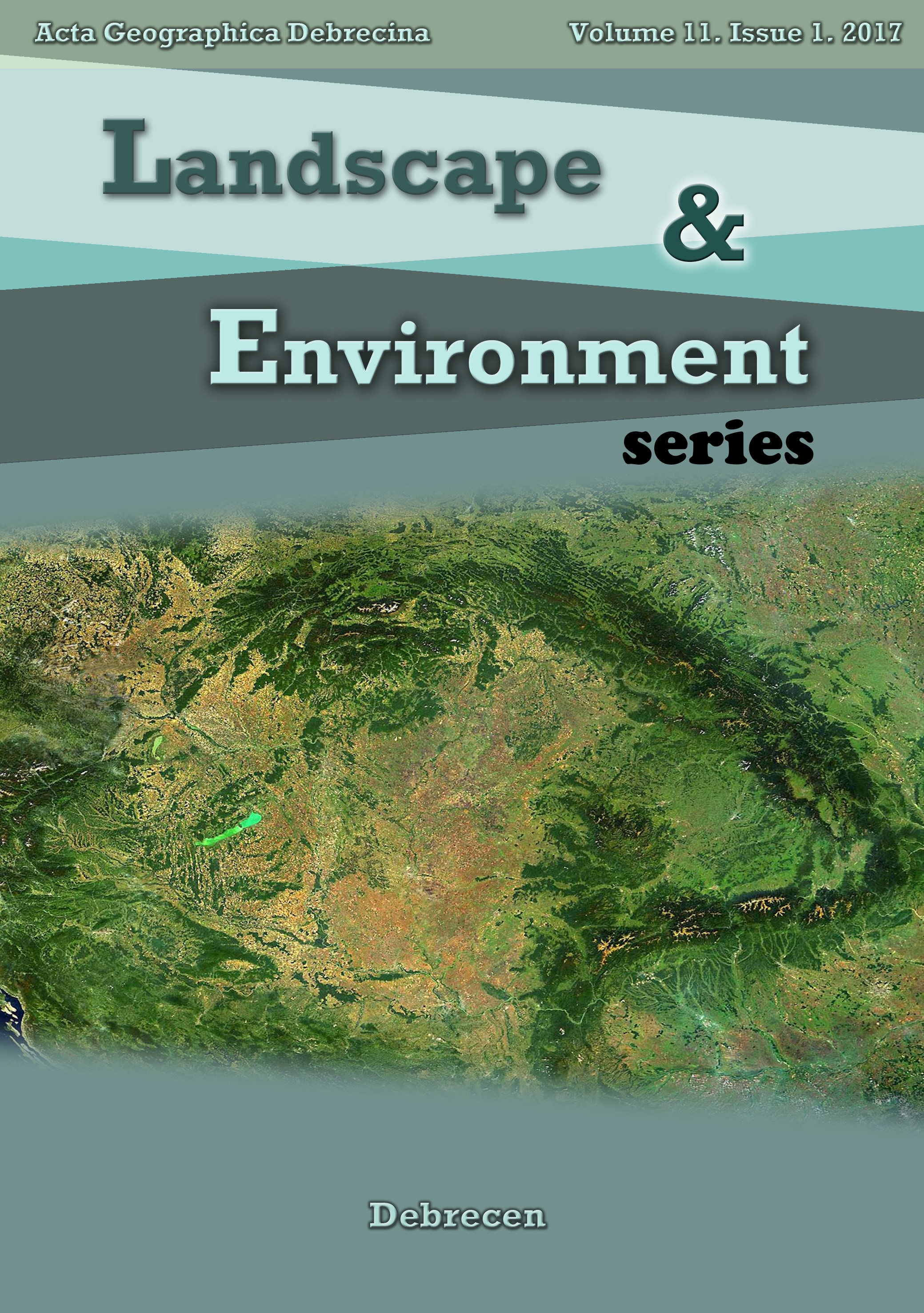Vol. 11 No. 1 (2017)
Md. Sanaul Haque Mondal. Population an land cover dinamics of Sundarbans impact zone is Bangladesh
G. Molnár – A. Scholtz – R. Vass. Accumulation studies at specific sampling areas of the active floodplain in the Upper-Tisza region
A. Hervai – E. Pirkhoffer – Sz. Á. Fábián – Á. Halmai – G. Nagy – D. Lóczy – Sz. Czigány. Interpolation and 3D visualization of soil moisture
H. Etigemane Ramappa – D. Muniswamy. Spatial Distribution of Heavy Metals around the Gold Mine Ore Tailings of Hatti, Karnataka State, India
##issue.tableOfContents##
Articles
-
Population an land cover dinamics of Sundarbans impact zone is Bangladesh
1-13Views:352Sundarbans is the largest mangrove forest of the world that lies in Bangladesh and India. This paper examined the correlation among population dynamics of Sundarbans impact zone (SIZ) from 1974 to 2011; impact of climate change on the forest; and changes in land cover of the forest from 1973 to 2010. Population size of SIZ was increased by 1.6 times between 1974 and 2011, whereas decreased by 2% during 2001 to 2011. During 1973 to 2010, water bodies, barren land and vegetated land reduced by 7.35%, 49.56% and 15.92% respectively; while grass land increased by 228.14% during the same period. But both population size and vegetated land declined during 2001 and 2011. This was due to the landfall of two severe cyclones in 2007 and 2009 through Sundarbans which resulted thousands of human casualties and out migration, and destruction of the forest. In addition, anthropogenic interventions like low flow from Ganges River and policy constraints also contributed to the demolition of Sundarbans. Thus, population growth, climate change and anthropogenic interventions are playing a decisive role to the depletion of forest resources from the Sundarbans mangrove forest.
pdf144 -
Accumulation studies at specific sampling areas of the active floodplain in the Upper-Tisza region
14-22Views:314In this paper the rate of accumulation was studied along four VO floodplain cross sections of the UpperTisza region between 1974 and 2014. VO floodplain cross sections are based on a mapping base-point grid (established in 1890), and they are located a few kilometers from each other. Furthermore, the roughness changes of different surface types, crossed by the VO floodplain cross-sections, were also determined between 1965 and 2015. The accumulation studies were extended to include the accumulation rates of the cut off meanders located along and/or close to the VO cross-sections. The roughness values increased in all four floodplain VO cross-sections since 1965; in two of them it reached or approximated 100 %. The average accumulation along the VO cross-sections was between 28 and 47 cm (0.73–1.23 cm/year) during the 38-year period. However, its areal distribution showed large differences. The highest values (169–309 cm, i.e. 4.44–8.13 cm/year) were found at the lowest points of the cut off meanders and swales in every case. The accumulation rate of the examined three cut off meanders near the floodplain cross-sections (140 and 1570 meters from the river bed) was lower (0.84–2.5 cm/year), but the study period was significantly longer (154 and 161 years, respectively). Comparing the values of the two periods, it is obvious that the accumulation of the active floodplain accelerates, presumably due to the significant increase of surface roughness.
pdf97 -
Interpolation and 3D visualization of soil moisture
23-34Views:528Adaptation to climate change demands the optimal and sustainable water management in agriculture, with an inevitable focus on soil moisture conditions. In the current study we developed an ArcGIS 10.4. platform-based application (software) to model spatial and temporal changes in soil moisture in a soy field. Six SENTEK Drill & Drop soil moisture sensors were deployed in an experimental field of 4.3 hectares by the contribution of Elcom Ltd. Soil moisture measurement at each location were taken at six depths (5, 15, 25, 35, 45 and 55 cm) in 60-minute intervals. The model is capable to spatially interpolate monitored soil moisture using the technique. The time sequence change of soil moistures can be tracked by a Time Slider for both the 2D and 3D visualization. Soil moisture temporal changes can be visualized in either daily or hourly time intervals, and can be shown as a motion figure. Horizon average, maximum and minimum values of soil moisture data can be identified with the builtin tool of ArcGIS. Soil moisture spatial distribution can be obtained and plotted at any cross sections, whereas an alarm function has also been developed for tension values of 250, 1,000 and 1,500 kPa.
pdf178 -
Spatial Distribution of Heavy Metals around the Gold Mine Ore Tailings of Hatti, Karnataka State, India
35-44Views:581Mining is an imperative segment of the world economy as it contributes socio-economic status of the nations. However, developing countries like India due to lack of high profile industrial techniques and equipment, eluting effluents from the industrial process may contain various hazardous substances which greatly affect the environmental and human health. The present work is aimed with the distribution of heavy metals in and around Hatti Gold Mine Ore Tailing (H-GOT). The results elicit the mine ore tailings are having high-level contaminants of heavy metal than the crop lands of Hatti (Hs), Kotha (Ks), Chikka Nagur (Cs), Tawag (Ts), Lingsugur (Ls) of Raichur District, Karnataka. It was reported that, Hatti Gold Mine ore tailings hold about 41.31±0.49 mg/kg, 2.1±0.31mg/kg, 71.96±3.26 mg/kg, 39.56±1.47 mg/kg and 73.4±2.19 mg/kg of Arsenic (As), Cadmium (Cd), Copper (Cu), Lead (Pb) and Zinc (Zn) heavy metals respectively. While the crop lands metal contamination range depends on seasonal variation. In south-west monsoon farming lands metal contamination order is Hs> Ks>Cs> Ts >Ls, and it was decreased during Post-monsoon. This is the hallmark of the fetching huge amount of toxic heavy metals from mining center to nearest crop lands. The continuous squeezing of these toxic metals could trigger the bio-magnification in both aquatic and terrestrial ecosystem and it may impact various metabolic disorders.
pdf157
